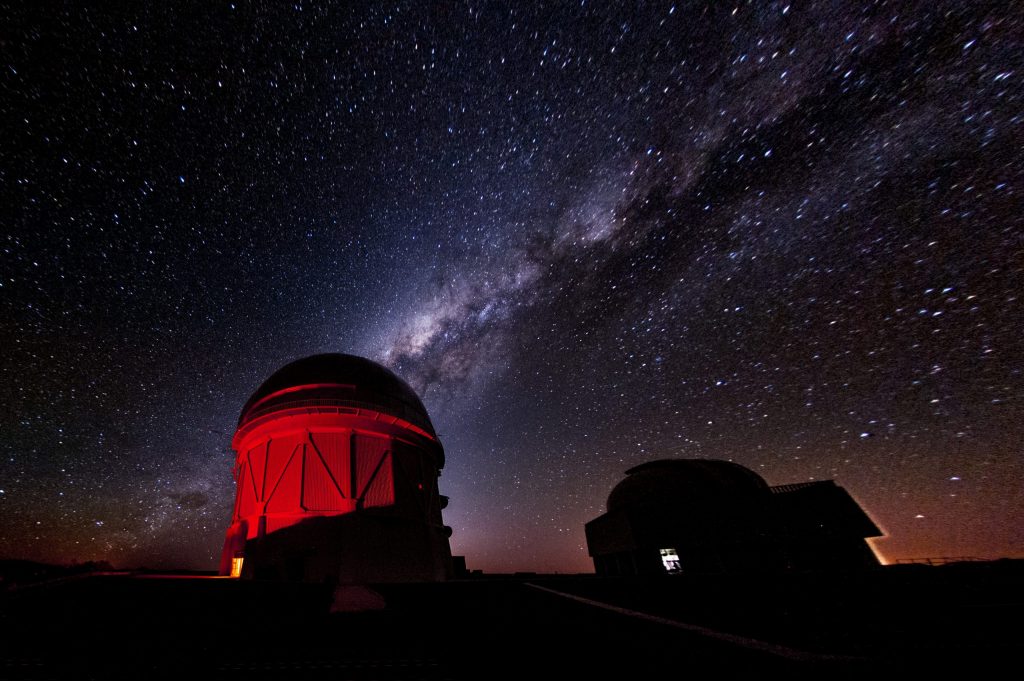
The Dark Energy Survey has imaged roughly 5,000 square degrees of southern sky. The survey has mapped hundreds of millions of galaxies to help researchers understand the accelerating expansion of our universe. Photo: Reidar Hahn, Fermilab
New results from the Dark Energy Survey use the largest ever sample of galaxies over an enormous piece of the sky to produce the most precise measurements of the universe’s composition and growth to date. Scientists measured that the way matter is distributed throughout the universe is consistent with predictions in the standard cosmological model, the best current model of the universe.
Over the course of six years, DES surveyed 5,000 square degrees — almost one-eighth of the entire sky — in 758 nights of observation, cataloguing hundreds of millions of objects. The results announced today draw on data from the first three years — 226 million galaxies observed over 345 nights — to create the largest and most precise maps yet of the distribution of galaxies in the universe at relatively recent epochs.
Since DES studied nearby galaxies as well as those billions of light years away, its maps provide both a snapshot of the current large-scale structure of the universe and a movie of how that structure has evolved over the course of the past 7 billion years.
To test cosmologists’ current model of the universe, DES scientists compared their results with measurements from the European Space Agency’s orbiting Planck observatory. Planck used light signals known as the cosmic microwave background to peer back to the early universe, just 400,000 years after the Big Bang. The Planck data give a precise view of the universe 13 billion years ago, and the standard cosmological model predicts how the dark matter should evolve to the present. If DES’s observations don’t match this prediction, there is possibly an undiscovered aspect to the universe. While there have been persistent hints from DES and several previous galaxy surveys that the current universe is a few percent less clumpy than predicted — an intriguing find worthy of further investigation — the recently released results are consistent with the prediction.
“In the area of constraining what we know about the distribution and structure of matter on large scales as driven by dark matter and dark energy, DES has obtained limits that rival and complement those from the cosmic microwave background,” said Brian Yanny, a Fermilab scientist who coordinated DES data processing and management. “It’s exciting to have precise measurements of what’s out there and a better understanding of how the universe has changed from its infancy through to today.”
Ordinary matter makes up only about 5% of the universe. Dark energy, which cosmologists hypothesize drives the accelerating expansion of the universe by counteracting the force of gravity, accounts for about 70%. The last 25% is dark matter, whose gravitational influence binds galaxies together. Both dark matter and dark energy remain invisible and mysterious, but DES seeks to illuminate their natures by studying how the competition between them shapes the large-scale structure of the universe over cosmic time.
DES photographed the night sky using the 570-megapixel Dark Energy Camera on the Victor M. Blanco 4-meter Telescope at the Cerro Tololo Inter-American Observatory in Chile, a program of the National Science Foundation’s NOIRLab. One of the most powerful digital cameras in the world, the Dark Energy Camera was designed specifically for DES. It was funded by the Department of Energy and was built and tested at Fermilab. The DES data were processed at the National Center for Supercomputing Applications at the University of Illinois at Urbana-Champaign.
“These analyses are truly state-of-the-art, requiring artificial intelligence and high-performance computing super-charged by the smartest young scientists around,” said Scott Dodelson, a physicist at Carnegie Mellon University who co-leads the DES Science Committee with Elisabeth Krause of the University of Arizona. “What an honor to be part of this team.”
To quantify the distribution of dark matter and the effect of dark energy, DES relied on two main phenomena. First, on large scales, galaxies are not distributed randomly throughout space but rather form a web-like structure due to the gravity of dark matter. DES measured how this cosmic web has evolved over the history of the universe. The galaxy clustering that forms the cosmic web, in turn, revealed regions with a higher density of dark matter.
Second, DES detected the signature of dark matter through weak gravitational lensing. As light from a distant galaxy travels through space, the gravity of both ordinary and dark matter can bend it, resulting in a distorted image of the galaxy as seen from Earth. By studying how the apparent shapes of distant galaxies are aligned with each other and with the positions of nearby galaxies along the line of sight, DES scientists inferred the spatial distribution (or clumpiness) of the dark matter in the universe.
Analyzing the massive amounts of data collected by DES was a formidable undertaking. The team began by analyzing just the first year of data, which was released in 2017. That process prepared the researchers to use more sophisticated techniques for analyzing the larger data set, which includes the largest sample of galaxies ever used to study weak gravitational lensing.
For example, calculating the redshift of a galaxy — the change in light’s wavelength due to the expansion of the universe — is a key step toward measuring how both galaxy clustering and weak gravitational lensing change over cosmic history. The redshift of a galaxy is related to its distance, which allows the clustering to be characterized in both space and time.
“There was significant improvement in how to calibrate the redshift distributions of the galaxy samples,” said Judit Prat, a postdoc at the University of Chicago who analyzed weak gravitational lensing as captured by DES. “This was a huge effort that people put a lot of work into. We now have a method that nobody has used before, and it’s very robust.”
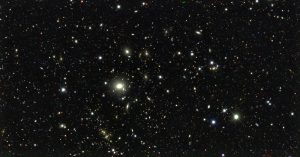
Ten areas in the sky were selected as “deep fields” that the Dark Energy Camera imaged multiple times during the survey, providing a glimpse of distant galaxies and helping determine their 3D distribution in the cosmos. Photo: Dark Energy Survey
Ten regions of the sky were chosen as “deep fields” that the Dark Energy Camera imaged repeatedly throughout the survey. Stacking those images together allowed the scientists to glimpse more distant galaxies. The team then used the redshift information from the deep fields to calibrate measurements of redshift in the rest of the survey region. This and other advancements in measurements and modeling, coupled with a threefold increase in data compared to the first year, enabled the team to pin down the density and clumpiness of the universe with unprecedented precision.
Along with the analysis of the weak-lensing signals, DES also precisely measures other probes that constrain the cosmological model in independent ways: galaxy clustering on larger scales (baryon acoustic oscillations), the frequency of massive clusters of galaxies, and high-precision measurements of the brightnesses and redshifts of Type Ia supernovae. These additional measurements will be combined with the current weak-lensing analysis to yield even more stringent constraints on the standard model.
“DES has delivered cost-effective, leading-edge science results directly related to Fermilab’s mission of pursuing the fundamental nature of matter, energy, space and time,” said Fermilab Director Nigel Lockyer. “A dedicated team of scientists, engineers and technicians from institutions around the world brought DES to fruition.”
The DES collaboration consists of over 400 scientists from 25 institutions in seven countries.
“The collaboration is remarkably young. It’s tilted strongly in the direction of postdocs and graduate students who are doing a huge amount of this work,” said DES Director and spokesperson Rich Kron, who is a Fermilab and University of Chicago scientist. “That’s really gratifying. A new generation of cosmologists are being trained using the Dark Energy Survey.”
DES concluded observations of the night sky in 2019. With the experience of analyzing the first half of the data, the team is now prepared to handle the complete data set. The final DES analysis is expected to paint an even more precise picture of the dark matter and dark energy in the universe. And the methods developed by the team have paved the way for future sky surveys to probe the mysteries of the cosmos.
“The real legacy of DES will be the leaps forward we’ve had to make that were essential for this key result, and which will be critical for the next generation of cosmological experiments starting soon,” said Michael Troxel, a physicist at Duke University and the key project coordinator for the DES three-year data analysis. Upcoming experiments include both space-based imaging experiments and ground-based surveys such as the Vera C. Rubin Observatory Legacy Survey of Space and Time.
“With these instruments we’ve built to stare into the dark, we are working to solve universal mysteries,” said Troxel.
The recent DES results will be presented in a scientific seminar on May 27. Twenty-nine papers are available on the arXiv online repository.
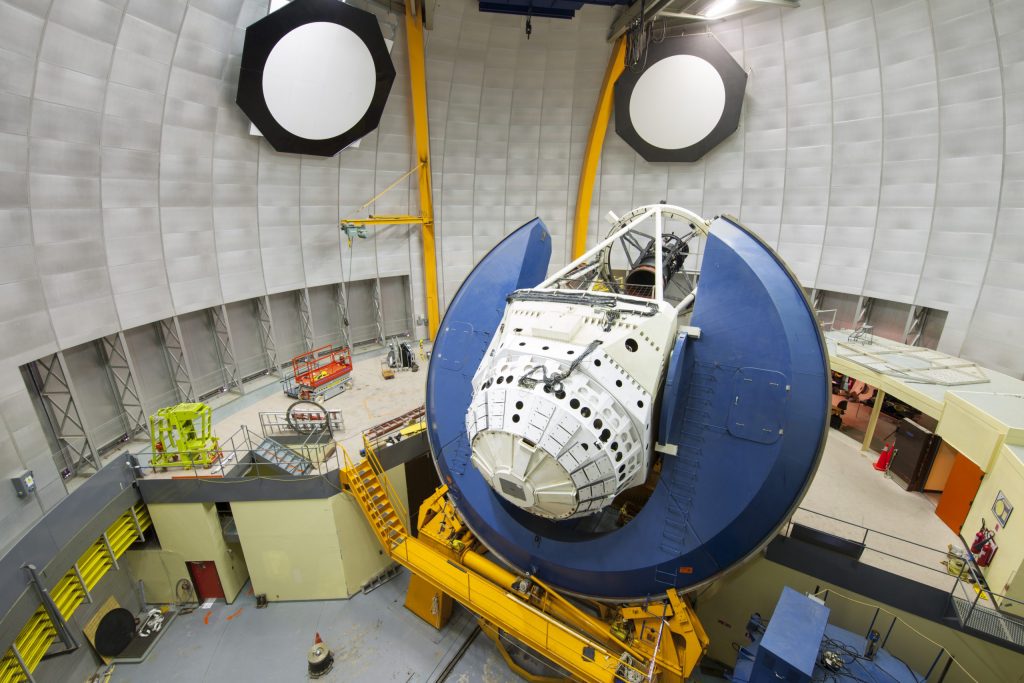
The Dark Energy Survey photographed the night sky using the 570-megapixel Dark Energy Camera on the Victor M. Blanco 4-meter Telescope at the Cerro Tololo Inter-American Observatory in Chile, a program of the National Science Foundation’s NOIRLab. Photo: Reidar Hahn, Fermilab
Funding for the DES Projects has been provided by the U.S. Department of Energy, the U.S. National Science Foundation, the Ministry of Science and Education of Spain, the Science and Technology Facilities Council of the United Kingdom, the Higher Education Funding Council for England, the National Center for Supercomputing Applications at the University of Illinois at Urbana-Champaign, the Kavli Institute of Cosmological Physics at the University of Chicago, Funding Authority for Funding and Projects in Brazil, Carlos Chagas Filho Foundation for Research Support of the State of Rio de Janeiro, Brazilian National Council for Scientific and Technological Development and the Ministry of Science and Technology, the German Research Foundation and the collaborating institutions in the Dark Energy Survey.
Cerro Tololo Inter-American Observatory is a program of NSF’s NOIRLab, which is operated by the Association of Universities for Research in Astronomy (AURA) under a cooperative agreement with the National Science Foundation. NSF is an independent federal agency created by Congress in 1950 to promote the progress of science. NSF supports basic research and people to create knowledge that transforms the future.
NCSA at the University of Illinois at Urbana-Champaign provides supercomputing and advanced digital resources for the nation’s science enterprise. At NCSA, University of Illinois faculty, staff, students and collaborators from around the globe use advanced digital resources to address research grand challenges for the benefit of science and society. NCSA has been advancing one third of the Fortune 50® for more than 30 years by bringing industry, researchers and students together to solve grand challenges at rapid speed and scale. For more information, please visit www.ncsa.illinois.edu.
Fermilab is America’s premier national laboratory for particle physics and accelerator research. A U.S. Department of Energy Office of Science laboratory, Fermilab is located near Chicago, Illinois, and operated under contract by the Fermi Research Alliance LLC. Visit Fermilab’s website at www.fnal.gov and follow us on Twitter at @Fermilab.
The DOE Office of Science is the single largest supporter of basic research in the physical sciences in the United States and is working to address some of the most pressing challenges of our time. For more information, please visit science.energy.gov.
The Fermilab-hosted Deep Underground Neutrino Experiment is an enormous international scientific effort. More than a thousand researchers aim to shed light on elusive subatomic particles known as neutrinos — and possibly the nature of matter itself.
It’s also going to be physically enormous. The experiment will send the world’s most intense high-energy neutrino beam from U.S. Department of Energy’s Fermilab in Illinois to huge particle detectors 800 miles away at the Sanford Underground Research Facility in South Dakota. Each of the four neutrino detector modules will be four-stories high and over 200 feet long. Construction crews will excavate almost 800,000 tons of rock to create the gigantic caverns of the Long-Baseline Neutrino Facility that will house these detectors.
The challenge? Everything required to build the LBNF caverns in South Dakota, as well as the future particle detectors, must be lowered a mile below the surface of the Earth through a 13- by 5-foot shaft compartment and then assembled underground, like a ship in a bottle. Even the large machines necessary to remove the rock must follow the process.
On April 5, Thyssen Mining, the company contracted to carry out the excavation, received the green light to start underground work. Thyssen will bring about 35 pieces of equipment underground — around 30 will need to be disassembled to some degree to fit down the shaft. It will take about three months to mobilize all of the heavy equipment underground.
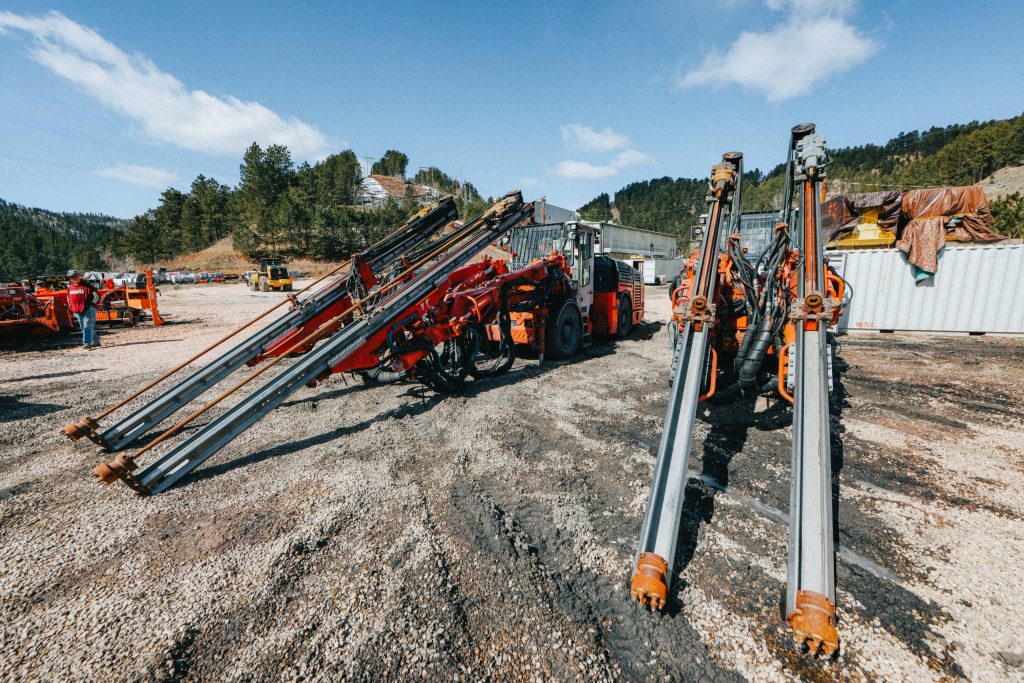
These two jumbo drill rigs are some of the equipment that construction crews will use for the excavation of the caverns for the Deep Underground Neutrino Experiment. Before being lowered underground through the mile-deep Ross Shaft, they first need to be partially disassembled. Photo: Matthew Kapust, Sanford Underground Research Facility
“These machines are designed for mines, so they come in components, and the contractor looks at what size components can fit inside the hoist cage,” said James Rickard, the Fermilab resident engineer managing the excavation construction. “They try to break it down as minimally as possible” to fit the pieces into the 12-foot-tall cage. Long, narrow pieces are slung underneath the cage.
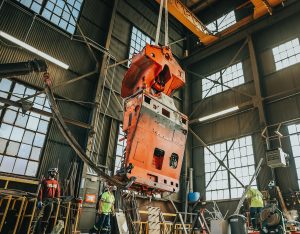
This drill rig has been disassembled to prepare it for delivery to the LBNF work area a mile underground. Prior to lowering any large piece of equipment, crews perform a test sling to understand how to rig the piece so it hangs properly while traveling through the shaft. Photo: Adam Gomez, SURF
One of the first machines that will be brought in pieces down the shaft is a raise bore machine. Starting in May, the raise bore will be used to drill a pilot hole for a 1,200-foot-long ventilation shaft to increase airflow and allow heat to escape from the underground lab. After the 13-inch pilot hole is drilled, the drill is attached to a 12-foot reamer that is then pulled back up the 1,200 feet creating the full-size shaft. The shaft will be completed in fall 2021.
Other machines Thyssen will move underground include extendable forklifts called telehandlers; multifunctional skid steers; durable load, haul and dump machines; and jumbo drills that will create blasting holes. The equipment is coming to South Dakota from Thyssen’s headquarters in Nevada and Saskatchewan, as well as from project sites in the United States and Canada.
An automated rock bolter is being shipped to the site directly from the manufacturer in Finland. Its role is to install 20-foot-long steel bolts into the cavern, reinforcing the roof and walls. The machine boasts an advanced computer control system to accurately position the bolts, as well as advanced safety features and lower emissions. It will be one of only two such machines in the world.
Machines that have already arrived are being stored at an offsite yard, waiting their turn to be brought to the subterranean construction site. Once underground, the equipment will be stored in existing drifts and tunnels until an equipment and maintenance shop can be established.
The first underground blast for LBNF by Thyssen is scheduled for June. The main cavern excavation work will begin in August and continue for two-and-a-half years.
“It’s a pretty exciting time,” said Andrew Hardy, Thyssen’s project manager for the excavation. “We thought we already had a lot of activity up to this point, but now it really begins.”
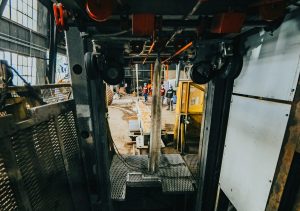
A large support beam, too long to fit inside the cage of the Ross Shaft, is prepped for underground delivery by slinging it underneath the cage. The beam will be used to support drilling equipment. Credit: Adam Gomez, SURF
Once the subterranean work gets going, Thyssen will use the cage hoist daily to transport not only machinery but also materials, safety supplies, and people. The company has contracted 90 miners, mechanics and electricians split into three rotating crews, along with a surface support team of engineers, planners, buyers, safety coordinators and administrators, to keep the work going 24/7.
There is much excitement about moving towards the more substantial construction work for LBNF after over three years of pre-excavation work and reliability projects such as refurbishing the nearly 90-year-old hoists.
“I can’t wait,” said Fermilab’s Michael Gemelli, the LBNF Far-Site Conventional Facilities project manager. “I’m looking forward to the next stage of this project. The site project team has done so much great work to set the stage for the excavation work to commence.”
Fermilab is supported by the Office of Science of the U.S. Department of Energy. The Office of Science is the single largest supporter of basic research in the physical sciences in the United States and is working to address some of the most pressing challenges of our time. For more information, visit science.energy.gov.
DOE’s Office of Science is the single largest supporter of basic research in the physical sciences in the United States and is working to address some of the most pressing challenges of our time. For more information, please visit science.energy.gov.
The ICARUS detector, part of Fermilab’s Short-Baseline Neutrino Program, will officially start its hunt for elusive sterile neutrinos this fall. The international collaboration led by Nobel laureate Carlo Rubbia successfully brought the detector online and is now collecting test data and making final improvements.
When teams began cooling the ICARUS neutrino detector and filling it with 760 tons of liquid argon in early 2020, few people knew how much the world would change in the two months that the fill would take.
“In an ideal world, as soon as the filling is complete and the cryogenic plant is stabilized, then we can activate the detector and start looking for particle tracks basically immediately,” said Angela Fava, the ICARUS commissioning coordinator and deputy technical coordinator.
The ICARUS collaboration includes more than 150 scientists from 23 institutions in Italy, Mexico, Switzerland and the United States. The detector is located at the U.S. Department of Energy’s Fermi National Accelerator Laboratory, located near Chicago.
Restrictions on international travel instituted last year due to the COVID-19 pandemic meant that many European experts could not come to Fermilab in person as planned to start up the detector components. Researchers restructured their plans to get the detector up and running with much of the team working remotely.
The collaboration successfully activated ICARUS in August 2020 and recorded the first particle tracks — from cosmic rays, particles from space that constantly bombard Earth — soon after. Exposed to both the Booster and NuMI neutrino beams at Fermilab, the ICARUS detector has recorded the first muon and electron neutrinos, demonstrating the high-level detection capabilities of the liquid-argon time projection chamber technique.

The ICARUS detector has been collecting test data in preparation for the official start of the physics data collection later this year. The left panel shows an electron neutrino interaction that produced a proton (top track) and an electron, which produced an electromagnetic shower with photons and electrons (bottom tracks). The right panel shows a muon neutrino interaction that produced a proton (short track, top left) and a muon (3.4-meter-long track); a cosmic-ray track independent of the muon neutrino interaction is also visible in the lower half of the image. In both panels, the neutrino beam came from left. Image: ICARUS collaboration
The team is now working on finishing the system to identify and exclude cosmic-ray signals. They are also making final improvements to the neutrino data acquisition system to prepare the detector for its official first data collection run in fall 2021.
“We’ve been able to do our jobs with most people not moving from their local offices or homes,” said Claudio Montanari, the ICARUS technical coordinator. “Everybody contributed to the best of their ability, which was key to the success of the operation.”
Searching for stealth particles
When the ICARUS detector was originally assembled at the laboratories of the Italian National Institute for Nuclear Physics in Pavia in the early 2000s, it was the largest liquid-argon detector in the world. It began its neutrino-hunting career at Italy’s Gran Sasso National Laboratory in an experiment that ran between 2010 and 2014.
After the experiment in Italy concluded, scientists realized that the ICARUS detector could have a second life at Fermilab, searching for a new type of particle: the sterile neutrino.
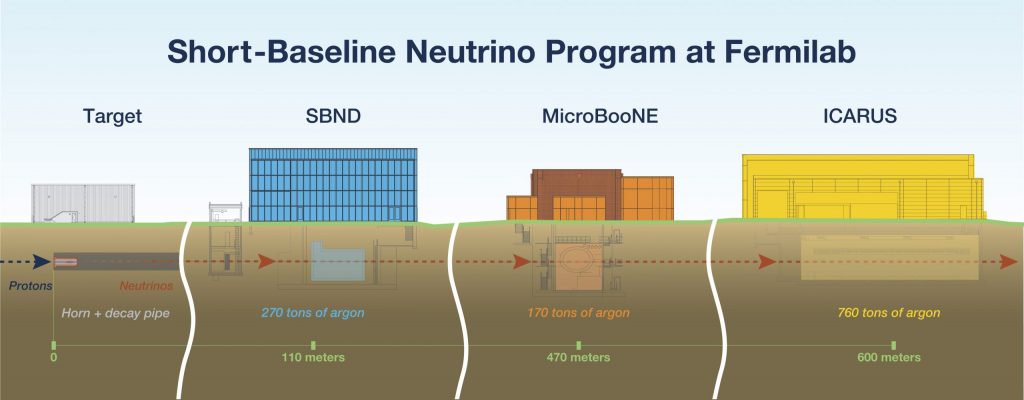
ICARUS will be the largest and farthest detector in the Short-Baseline Neutrino program at Fermilab, which examines neutrino oscillations over short distances and looks for hints of elusive sterile neutrinos. Graphic: Fermilab
Scientists already know of three types, or flavors, of neutrinos. The particles are notoriously hard to catch because they interact through only two of the four known forces: gravity and the weak force. But this potential fourth kind of neutrino — if it exists — may not even be sensitive to weak interaction, making detection even trickier. Scientists will have to look carefully at how the different flavors of neutrinos morph into one another, a phenomenon called neutrino oscillation.
Previous experiments saw hints of unusual oscillation, but researchers need more data to determine if sterile neutrinos were responsible for the results. Finding evidence of sterile neutrinos would advance scientists’ knowledge about physics beyond the Standard Model, the theoretical framework that has accurately described almost all known subatomic particle interactions for over 50 years.
To make this happen the ICARUS detector’s two school-bus-size modules were shipped from Gran Sasso to CERN for upgrades. In 2017, the two modules travelled by truck and ship to Fermilab, where they will soon begin hunting for ultra-elusive sterile neutrinos.
ICARUS is one of three particle detectors at Fermilab that will look for indicators of sterile neutrinos as part of the laboratory’s Short-Baseline Neutrino Program, along with the Short-Baseline Neutrino Detector and MicroBooNE. Together, the detectors will analyze how neutrinos oscillate as they travel along their straight beamline path through these detectors.
SBND, situated 110 meters from the start of the neutrino beamline, will provide a snapshot of the neutrinos right after they’re produced. MicroBooNE, located 360 meters farther down the beamline, will provide a second look at the beam composition. The final checkpoint is ICARUS, 600 meters from the start of the beamline. If ICARUS picks up fewer muon neutrinos and more electron neutrinos than expected based on data from SBND and MicroBooNE, “the combination of these things would be the unique signature of the oscillation and therefore of the existence of the sterile neutrino,” said Fava.
Preflight checklist
Getting ICARUS ready to search for signs of sterile neutrinos at Fermilab has involved three distinct stages: installation, activation and commissioning. Installation started in 2018 and included set up of the vacuum chambers, insulation, cryostats and various electronics used to power the detector and collect data.
After electrical safety checks, making sure the vacuum chambers were leak-free and testing the components’ basic functionality, it was time to get the detector ready for activation. Technicians started up the filters, pumps and condensers for the cryogenic systems and began adding the liquid argon in early 2020.
Collaborators from CERN and INFN with historical knowledge of the detector were present for the beginning of the fill. They left with plans to return to Fermilab in April 2020 to help wrap up the process and see the detector through to activation. While they were unable to return in person, the group successfully coordinated with the Fermilab branch of the team to complete the activation last summer.
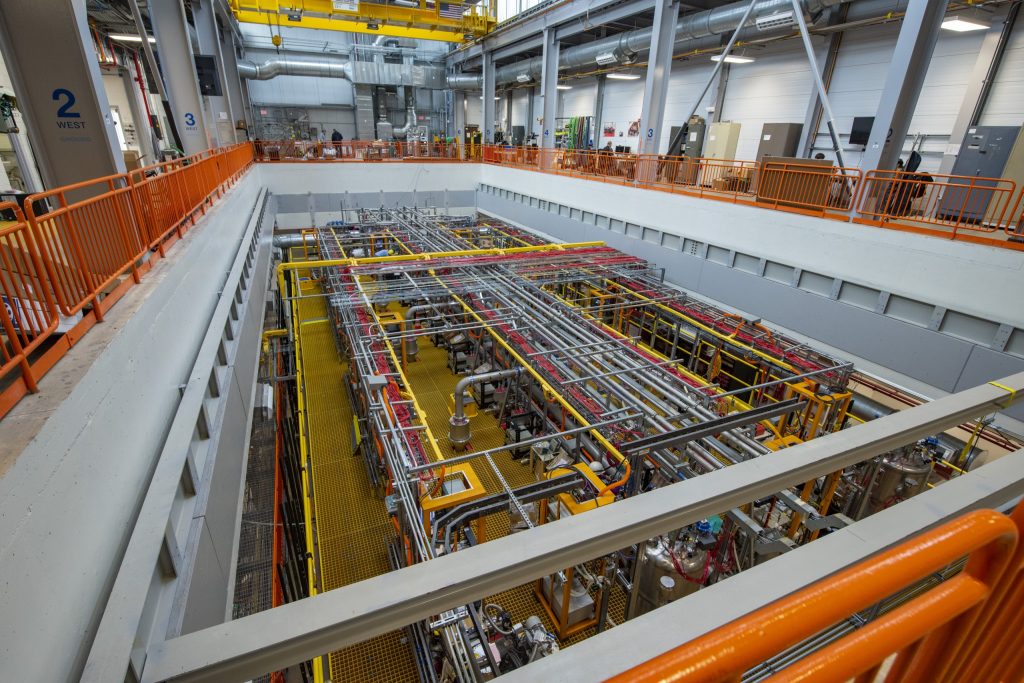
ICARUS was filled with 760 tons of super-pure liquid argon in early 2020 and activated in August. Photo: Lynn Allan Johnson, Fermilab
“We were lucky enough not to have any showstoppers,” said Montanari.
With the detector activated, the international collaboration turned its attention to debugging and optimizing the equipment. For example: To capture good neutrino data, the liquid argon inside the detector has to be ultra-pure. When researchers found the argon was less pure than expected, they traced the problem back to slow gaseous argon movement through the recirculation system and took steps to address the flow.
“That’s the life of a physicist — dealing with problems and finding a way of overcoming them,“ Fava said.
Since last year, ICARUS has been in the commissioning phase. The team is testing all of the subsystems to make sure they are in sync and calibrated to collect quality data with minimal noise before the start of official data collection.
Getting ready for takeoff
ICARUS began taking test data from the booster neutrino beam in December 2020. That data is now being used to refine the triggers for deciding what type of signal constitutes a particle “event” worthy of recording.
“The trigger system is one of the most critical components to commission, because it brings together all the other subsystems,” said Fava.
The trigger rate — how frequently the system records an event — must be finely tuned. If it’s too high, the researchers end up sifting through more data than they need to, wasting time and computing power. Too low, and they might miss recording particle interactions that are crucial to making a discovery. The team plans to test the next iteration of trigger logic in May.
In addition to refining the trigger, the ICARUS team will install a final set of cosmic-ray trackers. Roughly 10 cosmic rays hit the detector during each 1.6-millisecond time window used to record a potential neutrino interaction. The cosmic-ray trackers are used to sort out which signal is which.
“If there is an external signal and the timing is correct, we can reject that event on the basis that it was induced by a particle that was coming from outside,” said Montanari. Trackers on the bottom and sides have already been installed — all that’s needed now is to finish the top.
With everything expected to be in place this fall, the experiment will move into the next exciting stage: collecting high-quality data that will be used in scientists’ search for sterile neutrinos.
“I’m really looking forward to making a nice data analysis and seeing what nature is willing to tell us,” Montanari said.
ICARUS is supported by the U.S. Department of Energy Office of Science, the Italian National Institute for Nuclear Physics (INFN) and CERN, the European Organization for Nuclear Research.
Fermilab is America’s premier national laboratory for particle physics and accelerator research. A U.S. Department of Energy Office of Science laboratory, Fermilab is located near Chicago, Illinois, and operated under contract by the Fermi Research Alliance LLC.
The DOE Office of Science is the single largest supporter of basic research in the physical sciences in the United States and is working to address some of the most pressing challenges of our time. For more information, please visit science.energy.gov.
